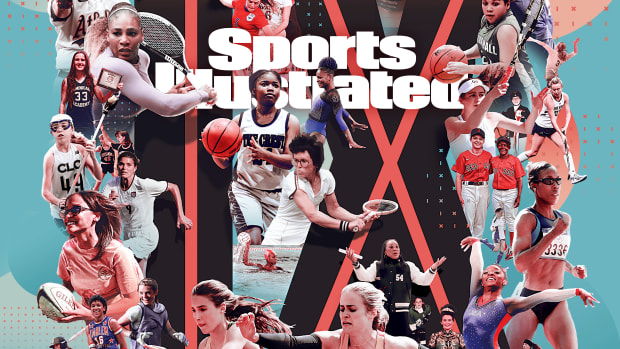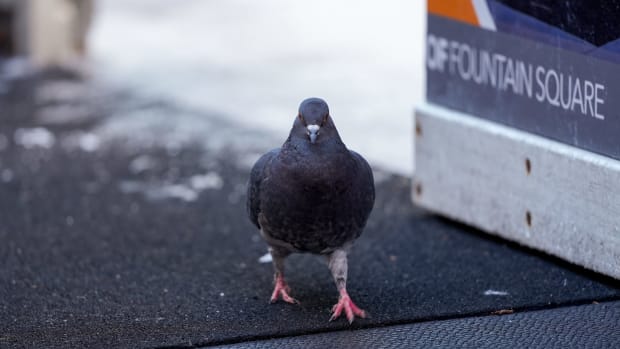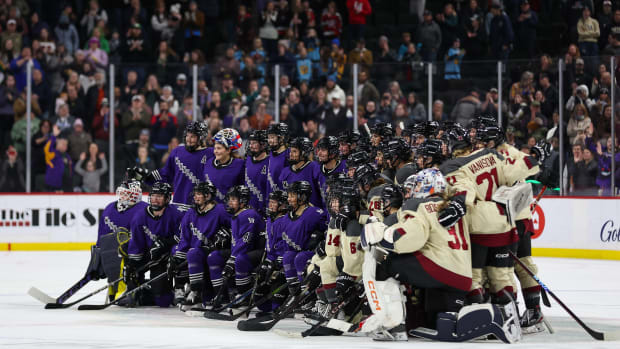
Stanford an intriguing matchup for SEC heavyweights; more Mailbag
In sight and sound, it was entirely different than visiting Alabama or LSU. However, the football team that took the field that night and ran for 446 yards against Washington may bear the closest resemblance nationally to those SEC heavyweights.
Just how good is Stanford? Its ground assault against Washington reminded me of those old Nebraska/Oklahoma beatdowns of the Big 8 era, only Stanford has an all-universe QB that barely had to break a sweat.-- Alex, Las Vegas
Should college football fans who want the SEC title reign run to end be rooting for Stanford? The Cardinal continue to play the most physical brand of football not seen in the Southeast, have a strong running game, and oh yeah, the best quarterback in the country. I feel like Stanford would be the prefect team to match up with LSU or Alabama.-- Josh Peterson, Omaha, Neb.
Stanford is the rare team one has to see in person to truly appreciate. For one thing, it hasn't played a high-caliber opponent since Virginia Tech in last year's Orange Bowl, so it's hard to read too much into the week-in, week-out blowouts. (Though it's quite the feat to become the first team in 75 years to win 10 straight games by at least 25 points.) It's also hard for many people, including me, to shed the stereotype that Stanford is a bunch of overachieving three-star recruits who can't possibly be as talented as the other championship contenders. The next two NFL drafts will debunk that myth, when most of the Cardinal's offensive line and two or three of their tight ends will get selected.
As Josh suggests, Stanford may well match up better with LSU and Alabama than most teams from a stylistic standpoint. At the core, the Tigers and Tide are where they are because they dominate the line of scrimmage. If someone's going to take them down, it's probably not going to be a spread team like Oklahoma State or Clemson. The result of such a matchup would probably be very much like the LSU-West Virginia game; Alabama's and LSU's defenses are too fast and too sound to let receivers or running backs run wild in open space.
But Jim Harbaugh built Stanford to win in the trenches. Its goal, like Alabama's and LSU's, is to wear down the opponent. David Shaw throws in numerous wrinkles, from the Wildcat to halfback passes to rotating three or four different backs and using three tight ends in the passing game, but it all starts with a standard pro attack. And then there's Andrew Luck. On both his touchdown passes against Washington's admittedly terrible defense, there was no apparent open receiver when he released. That's because Luck was throwing to the exact spot where he knew his receiver would end up based on the coverage. That's awfully hard to defend.
But Stanford is certainly fallible, and so far lightly tested. This week brings its first real road challenge at USC. It will be interesting to see how Stanford's defense -- still much more of an unknown than its offense -- handles Matt Barkley and Robert Woods. Oregon, which hung 52 on Stanford last season, visits a couple weeks later. Even if they survive the season unscathed, the Cardinal could fail to reach New Orleans due to their questionable schedule. But my guess is that the more people watch, the more they will become intrigued by the possibilities of an SEC-Stanford matchup.
OU's loss brings to mind a good debate: What is the most shocking upset ever by a team with a legitimate, crystallized opportunity (more likely very late in the season) to play for a national championship. By that I mean a No. 1 or 2 team losing to an opponent that's shown little sign it's capable.-- Michael Newman, Los Angeles
Timing plays such a big factor in the shock value that Texas Tech-Oklahoma does not even crack my top five of the BCS era, 28-point spread or not. It still happened in October. I'd go with:
1. Pittsburgh (4-7) beating No. 2 West Virginia (10-1) in Morgantown on the last night of the 2007 season. Four years later I still don't understand how it happened.
2. Kansas State (10-3) destroying No. 1 Oklahoma (12-0) 35-7 in the 2003 Big 12 championship game. The Sooners were so dominant to that point they were garnering "greatest team of all time" talk. Of course thanks to the old BCS formula, they still got to play LSU for the BCS title.
3. Michigan State (4-4) knocking off No. 1 Ohio State (8-0) in Columbus on Nov. 7, 1998. The Buckeyes hadn't won by fewer than 17 points all season, and the Spartans' coach at the time had gone 23-20-1 in four seasons. His name was Nick Saban.
4. Texas A&M (10-2) taking down Kansas State (11-0) in the 1998 Big 12 title game. UCLA's loss to Miami earlier that day had cleared a path for the Wildcats, and K-State blew a 15-point fourth quarter lead.
5. UCLA (6-5) beating BCS No. 2 USC (10-1) 13-9 at the Rose Bowl on the last day of the 2006 season. The Trojans had won seven straight in the series, including 66-19 a year earlier, and Karl Dorrell was the Bruins' coach.
Does Bob Stoops have an eternal free pass? It seems like every year since his national championship, Oklahoma is the consensus favorite, only to do something like lose at home to a 30-point underdog. Some coaches have websites created by their fans to have them fired, while OU fans can't bring themselves to dismantle the Bob Stoops shrine they keep in their garages. What would it take for him to be subject to just a little scrutiny?-- Greg Stange, Roanoke, Texas
Well one particular cartoonish ESPN talking head/OU homer you may be familiar with has already called for Stoops' dismissal. Anyone else who feels that way really needs his head examined.
Saturday's loss was indisputably embarrassing, but there's a reason it and certain other regrettable defeats (the USC title game blowout, the Boise State Fiesta Bowl, etc.) stand out: The Sooners lose so infrequently. Stoops has an .808 overall winning percentage, an 81-19 record against conference opponents and a 43-16 mark against ranked foes. He's won seven Big 12 titles in 12 seasons. Is there any school in the country that wouldn't take that?
Stoops' biggest problem has been perception. He raised the bar so high by winning a national championship in his second season, but 11 years have now passed without another. He's obviously going to take criticism every time the Sooners fall short again. But winning national titles isn't easy. Joe Paterno, Bobby Bowden and Tom Osborne each coached for multiple decades before winning their first. And Stoops has a higher winning percentage than Hall of Famers Paterno and Bowden.
For the second time this season, Miami has embarrassed a team in the lower part of the Top 25 (by nearly identical scores), and for the second time, remains unranked the next day. Can you explain why?-- Mark, Melbourne, Fla.
Yes. Miami is 4-3.
Watching the Michigan State-Wisconsin game, I thought the last play could have been called either way on the field. I certainly couldn't tell. However, I didn't think there was irrefutable evidence to overturn the call. Thus, in my opinion, if called down at the half-yard line, it should have been down at the half-yard line. Did you see a basis for overturning the call?-- Dave, Naperville, Ill.
Going by the strict definition of "irrefutable evidence," no, there was not a basis for overturning the call. I've seen plenty of calls that were more clearly incorrect that replay officials declined to overturn. And here's guessing this call would have stood had it taken place in nearly any other part of the game. But officials are human. They knew what was riding on the call. And the fact is, it was the right call. It was close, but I've yet to hear anyone who watched the replay say definitively that Keith Nichol didn't score. I certainly thought he did. Replay official Tom Herbert did the right thing, as officiating guru Mike Pereira reaffirmed the next day.
You continue to downplay Oregon, which, by the way, is just one spot below Stanford in the BCS poll. Stanford will struggle at USC and will be exposed just like last year by the Ducks. Stanford would have been blown out vs. Auburn and LSU. Sorry.-- David Miller, Calabasas, Calif.
So the Cardinal still have some convincing to do.
It occurs to me that UCLA might be the worst BCS coaching job out there. Is there a higher-profile gig with lower pay (especially for assistants living in Los Angeles) and fewer resources? Oregon and Oklahoma State have left no doubt that a university can win simply by pumping wads of cash into facilities, etc. UCLA seems to be proving the opposite is also true. If they fire Slick Rick, who can they reasonably expect to get to replace him?-- Robert, Portland
It's far from the worst (would you rather coach football at Duke?), but you make an excellent point that few outside of the West Coast realize. When expressing bewilderment over UCLA's continued struggles people mistakenly refer to the program's "great resources." What resources? Are there oil well in Westwood? UCLA is a beautiful campus with great academics in a talent-rich area, but it simply does not spend money on football. It's a basketball school. It's currently spending $100 million to renovate Pauley Pavilion while paying its football staff (including Rick Neuheisel) a combined $2.9 million -- which is less than Oregon's Chip Kelly makes himself. Its facilities lag behind most of the Pac-12 as well.
UCLA is going to have to spend more to get a top-flight coach, as the going rate for a proven head coach is $2 million-plus. I'd expect the school to make another run at Boise State's Chris Petersen and see if his mindset has changed at all since AD Gene Bleymaier's dismissal. Mike Bellotti continues to send mixed signals about a possible return to coaching. He'd make sense, too. But if you listen to the faithful, not much will change until the school rids itself of AD Dan Guerrero.
Stewart, consider a BCS title game between Stanford and LSU in the Superdome. It would be more than the football game, it would be an epic meeting between the wine and brie set and rabid Cajuns. I predict the cultural aftershock of that meeting would reverberate along the West Coast for a generation, regardless of the game outcome. If the Tigers were to lose, the aftershock of that would reverberate in the SEC for a generation.-- Carrell Killebrew, Austin, Texas
It would admittedly be quite a contrast, but I don't think we'll ever be able to top the 2008 Georgia-Hawaii Sugar Bowl for cultural mismatches. The night before the game, Bourbon Street was an army of Georgia fans in button-downs, khakis and ratty curved baseball caps (not just the frat boys, mind you; male Georgia alums retain this outfit well into adulthood) mixed with pockets of Warriors fans wearing leis and hula skirts. I'll never forget the crowd watching in awe and bewilderment as the Hawaii players performed their pregame haka dance. Maybe Stanford's players can launch a start-up dotcom at the 50-yard-line.
Stewart, Can you enlighten me as to why Oklahoma State is ranked No. 1 in the computer rankings? Is it based on the schedule played so far? It seems like LSU's nonconference slate of Oregon and West Virginia should have it ranked ahead of OSU.-- Ben, Golden, Colo.
Besides wins and losses, the BCS computers solely measure the strength of teams' schedules. The BCS doesn't allow margin of victory to be included. At first glance, one would assume LSU's schedule is stronger than Oklahoma State's due to LSU's two notable nonconference games against Oregon and West Virginia. But my guess is the computers are both rewarding the Cowboys for winning four of their seven games on the road (LSU has three road wins and a neutral-site contest among its eight victories) and penalizing the Tigers for playing an FCS foe. Northwestern State is No. 175 in Jeff Sagarin's ELO-CHESS rankings (the version the BCS uses). By comparison, Oklahoma State's lowest-ranked opponent, Arizona, is 91st.
The computers view Stanford so unfavorably (ninth) compared to the voters for largely the same reasons. The Cardinal have played Sagarin's 92nd-toughest schedule, with Washington their lone Top 50 foe to date. All of these numbers will fluctuate wildly the rest of the season as teams play more games and generate new sets of data.
Regarding the Mountain West/Conference USA new name: With a nod to Frank Costanza ........ CONFERENCE RESTOFUS.-- Chris McCabe, Los Angeles
Winner, winner, chicken dinner. No other entrants need apply.
While realizing you dislike realignment questions during the season, would you please explain the difference between Tier I, Tier II and Tier III television rights and how (or who) determines what games fall into which category? I can imagine the conflict between ESPN and Fox Sports over whether a game qualifies as a Tier I or Tier II game if the teams are average in conference play or how the Longhorn Network determines which game to air at the expense of ABC or Fox Sports.-- Matthew Ward, Washington D.C.
Believe it or not, I find this question more interesting than "If Boise State joins the Big East..." I know, I'm weird.
Tier I and II entered the public lexicon a few weeks ago with the Big 12 schools' (most notably Texas) agreement to grant those rights to the conference for six years, thus ensuring the schools can't go anywhere because their TV rights wouldn't follow them. Those terms have nothing to do with the importance of specific games or the quality of the teams involved. They refer to a league's national and regional contracts and which priority each network gets.
For instance, the SEC has a primary (Tier I) deal with CBS, which gets first choice of its games most weeks, and a secondary (Tier II) deal with ESPN, both for primetime ESPN/ESPN2/ESPNU games and its weekly syndicated SEC Network game (the former JP game). ABC/ESPN currently holds the Big 12's Tier I deal, while its Tier II games belong to FOX, which airs them on FX or Fox Sports Net. Any games not selected by those networks qualify as Tier III, and every league handles them differently. The Big Ten and (soon) the Pac-12 pool those rights for use on their conference networks. The SEC and Big 12 allow the schools to retain those rights. Some repackage them for Pay Per View or local broadcasts. Texas is showing them on the Longhorn Network.
Stewart, after this weekend's upsets I have to beg you to help the people of Tuscaloosa and Baton Rouge with your media influence. If there are multiple unbeaten teams at the end of the year please, please don't let Stanford play LSU or 'Bama in the national championship game. We cannot afford angry fans from Indianapolis or Miami descending upon our towns after Andrew Luck gets hurt in his first-ever game against a real defense.-- Todd, Tuscaloosa, Ala.
Ouch (literally). Good thing Luck has another year of eligibility.




